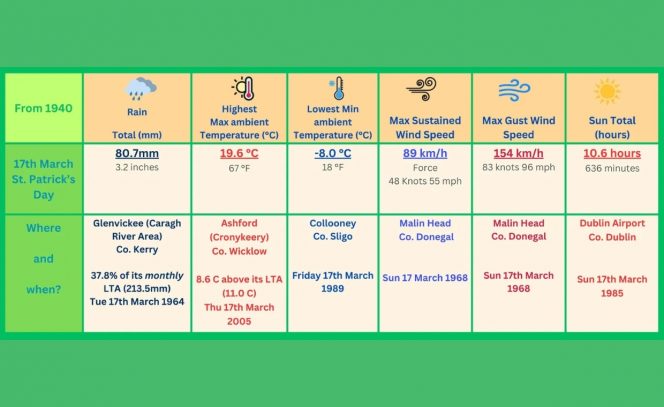A short history of extreme weather events around St Patrick's Day
Toggle
St Patrick's Day is celebrated as a religious and cultural holiday on March 17, the traditionally acknowledged date of the death of the primary patron saint of Ireland, St Patrick.
Many parades are organised across Ireland where people, typically dressed in green clothes or accessories, gather on the streets to celebrate this day among their communities and tourists.
But the enjoyment of outdoor festivities and their attendance can be impacted by severe weather, resulting in the disappointment of the crowds and affecting the generated revenue. You certainly will have your eyes on the weather forecast for the weekend, whether you are planning to join the crowds to watch a parade or take a short holiday to relax elsewhere in Ireland.
So were there any extreme weather events around St Patrick's Day in the past? Luckily, Ireland has a great heritage of historical instrumental and documentary sources, such as weather diaries and newspapers holding some examples of extreme weather events.
The Irish Annals contain the oldest records of examples of extreme weather events in Ireland. Despite the contradictory dates, a thunderstorm with lightning is said to have occurred either on St Patrick’s Day or the preceding night and killed 1,010 people in Co Clare in the early AD 800s according to the Annals of Clonmacnoise, Annals of Ulster and Chronicon Scotorum. Limerick was burnt by lightning in AD 1108, as reported in the Annals of the Kingdom of Ireland. The Annals of Ulster and the Annals of the Kingdom of Ireland refer to a thunderbolt on St Patrick’s Day on Croagh Patrick that killed 30 pilgrims in AD 1113.
Additionally, long snowfall periods are reported. A great snow from the celebrations of St Bridget to St Patrick in AD 1029 is mentioned in the Annals of Innisfallen. A great snow from the feast of the Immaculate Conception (December 8) to the feast of St Patrick caused human mortality and loss of cattle in AD 1047, as reported in the Annals of Ulster, Annals of the Kingdom of Ireland, Annals of Boyle and Annals of Four Masters.
A period of great hoar frost and snow took place from around mid-January to mid-March in AD 1115, causing human and cattle mortality, resulting in great scarcity in all of Ireland, namely in Leinster, as remarked in the Annals of Ulster, Annals of the Four Masters and The Annals of the Kingdom of Ireland. A great frost and snow occurred from January to the festivities of St Patrick in AD 1205, as indicated in the Annals of the Kingdom of Ireland.
 |
Weather diaries and newspapers narrated a few examples of extreme weather events on St Patrick's Day in the recent past. Isaac Butler highlighted cases of cold weather in Dublin, such as snowing all morning and freezing hard at night in 1717, very cold in 1724, very cold morning with sharp winds in 1725, and cold in 1726. Dr John Rutty also noted examples of cold weather in Dublin, such as a great fog and frost in 1761, plenty of snow in 1762 and a frost in 1765. At Newcastle West, it was reported as rainy all day with high wind and a great river flood in 1753. Examples of rainy weather are indicated in 1730 and 1759 in Dublin and in 1798 and 1816 at the Armagh Observatory.
A storm on 17 March 1861 was reported in Belfast by the Belfast News Letter on March 18. The event was described as a gale blowing from WNW from an early hour, accompanied by occasional hail and rain showers, resulting in steamers reaching the quays later than usual, slates blown off the roofs and a decrease in the number of people on the streets. In Dublin, the Evening Freeman described the same day as one the most inclement days characterised by cold winds blowing from westwards and heavy sleet showers, causing deserted streets due to the intensity of the cold.
The Cork Constitution of 18 March 1867 reported a storm in Cork starting at 3am on the previous day as a strong gale with heavy falls of snow, sleet and hail and cold, resulting in slates along pavements and large branches torn from trees and impeding the traffic of steamers.
St Patrick’s Day in 1876 was bitterly cold, and there were no outdoor celebrations in Belfast or the neighbourhood, according to the Northern Whig the following day. Celebrations passed "with unusual quietude" in Tralee, as the Kerry Evening Post reported on the same date.
The festivities were also reported as passing quietly in 1879 due to the snow, sleet or rain. The Belfast Morning News of March 18 reported a heavy downpour the previous morning in Dundalk, which prevented country people from travelling to Dundalk, and outdoor demonstrations were impeded in Lisburn due to the severity of the weather.
Taking the example of the historical air temperature record at Phoenix Park in Dublin, there were cases when the raw minimum air temperature was low on St Patrick’s Day, such as in 1845 (-5.6°C), 1887 (-6.5°C), 1888 (-5.2°C), 1894 (-3.4°C), 1900 (-4.5°C), 1909 (-5.6°C), 1911 (-4.5°C), 1924 (-4.4°C), 1929 (-3.9°C), 1930 (-3.3°C) or 1932 (-6.7°C). An unusual weather event, a tornado, was reported in Summerhill, Co. Meath, on St Patrick’s Day 1995.
From 1885 to 2023, Ireland's spring minimum and maximum air temperatures have significantly increased by 1.6°C and 1.7°C, respectively. In spring, there has been a significant decreasing trend in the frost days, cool nights and cool days, whereas there has been a significant increasing trend in the summer days, warm days and warm nights, and a warming of the temperatures of the coldest day and coldest night.
Photo credit: Kenneth Allen, CC BY-SA 2.0
This article originally appeared on RTÉ Brainstorm
